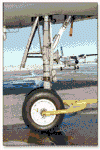
landing gear

Landplanes are fitted with either a nose wheel or
tailwheel. The landing gear not only has to support the
aircraft on the ground but must be capable of
withstanding the considerable stresses and shock
loadings experienced during landing. The gear is always
sprung. This can be by the use of spring metal, rubber
or by oleo. An oleo is in effect a spring and shock
absorber combined.

oleo construction
Most modern aircraft have
are fitted with a nosewheel (tricycle). Earlier designs
are most likely to have a tailwheel (taildragger).
tricycle
gear

tricycle gear

spring metal
landing gear of a fixed undercarriage
Nosewheel airplanes have the "third" wheel in
front of the main landing gear (i.e., under the
nose) as pictured below. Nose-wheel airplanes have
much better handling (due to less airplane behind
the pivot point) and visibility characteristics
while taxiing. Almost all new airplanes are
nose-wheel design. It is most important that the
pilot does not land the aircraft on the nose wheel. This
is called a ' wheelbarrow ' and often results in serious
damage.
The nose wheel is usually dampened with a shock absorber
or friction ring to prevent shimmy.
click here for shimmy animation.
A torque link is also fitted to maintain
correct nose-wheel alignment. Braking is usually
controlled from the tops of the rudder pedals, and a
separate parking brake is often fitted.
Most light aircraft have
steering nose wheels. When on the ground a linkage is
actuated between the rudder pedals and the nose wheel.
This disconnects automatically once that aircraft
leaves the ground. A small number of aircraft are fitted
with castoring nose wheels. Steering is effected
below rudder authority by the use of the differential
brakes on the main wheels. An example of an aircraft
with a castoring nose wheel is the Grumman Tiger series.
Many homebuilt aircraft are also similarly equipped.

castoring nose gear of
pilotfriend editor's retractable Glasair
Main Gear

typical light aircraft oleo main gear
Brakes are usually of the disc type and when
used differentially may be used to reduce turning
circles.
Creep marks are painted on
the tyre and wheel rim so that the pilot can check that
the tyre is not moving on the rim. A maximum of 1/4" is
permitted.
Tailwheel
These
airplanes have the "third" wheel under
the tail. Taildragger aircraft can land on much
rougher terrain and, consequently, are used by
bush pilots. In a tailwheel airplane, this gear
supports the weight of the rear portion of the
airplane. They are harder to control, (imagine
driving a rear steering dumper truck at high speed) and extra
training is required to handle them.

tailwheel retractable. The beautiful Globe Swift
monowheels with outriggers
A small number of
aircraft use a single central landing wheel and are
laterally supported by outriggers. Example are the
U2 spy plane and the homebuilt Europa. Ground
handling is not all that it could be with this
configuration.

the now defunct
Europa
Retractable
landing gear
Retracting the gear
reduces drag and increases airspeed without
additional power. The landing gear normally
retracts into the wing or fuselage through an
opening which may be covered by doors after the
gear is retracted. The smooth door will provide
for the unrestricted flow of air across the
opening that houses the gear. The retraction or
extension of the landing gear is accomplished
either electrically or hydraulically by landing
gear controls from within the cockpit. Warning
indicators are usually provided in the cockpit to
indicate whether the wheels are extended and
locked, or retracted. In nearly all airplanes
equipped with retractable landing gear, a system
is provided for emergency gear extension in the
event landing gear mechanisms fail to lower the
gear. The pilot operating manual will specify the
maximum speed at which the gear can be lowered.

retractable ('complex') aircraft in flight
|
